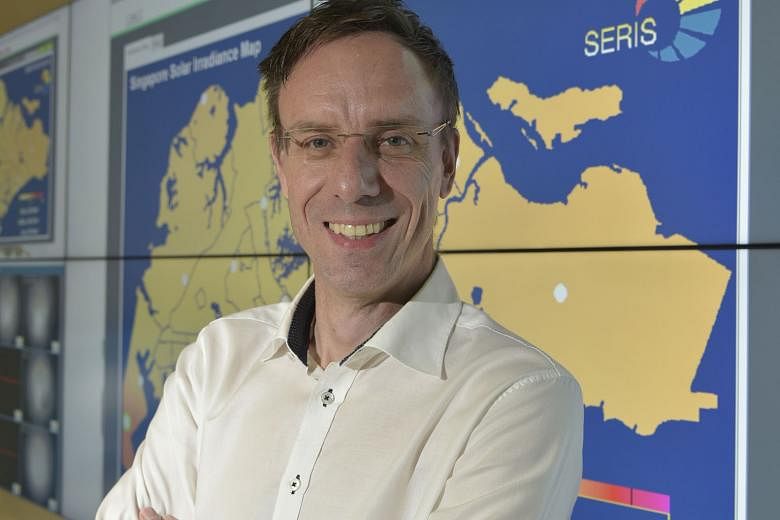Large solar farms require space that land-scarce Singapore does not have, but the Republic is looking outside the box to help it tap more energy from the sun.
An answer could lie in "urban solar plants" - easy-to-move systems that could see solar panels being deployed over open-air carparks one day, and idle areas slated for redevelopment the next.
This concept, which involves solar panels suspended from steel ropes, would make solar systems easy to set up and dismantle, so they can be deployed as and when land is available. They also remove the need for a large permanent space and support structures.
"Installing such a system over an open-air carpark would not only allow it to absorb the sun's energy, but it would also provide shade for cars. In the future, such systems could also power electric vehicles," said Dr Thomas Reindl, deputy chief executive of the Solar Energy Research Institute of Singapore at the National University of Singapore.
The study into how feasible urban solar plants are for Singapore is one of four projects he is leading to find out how solar energy can be made more viable here.
Dr Reindl and his collaborators, from organisations such as solar energy firm Sunseap, have received $4 million in funding from the Economic Development Board (EDB), as part of the 13th and final grant call for the Energy Innovation Research Programme.
The $140 million, five-year programme on energy research was announced in 2011 as part of the national Research, Innovation and Enterprise 2015 cycle. About $13 million was awarded to three research teams under the final grant call, including the one led by Dr Reindl.
There has been plenty of research done in Singapore and around the world on how to make solar panels more efficient at converting sunlight into electricity.
But Dr Reindl's projects are novel because they look at how to improve the entire system, not just the solar panels. They include studies on how to make the installation, operation and maintenance of solar installations more cost-effective, and how to increase energy harvest beyond the expected lifespan of 25 years.
If the urban solar plant project is found to be feasible and scaled up, for instance, it could help lower the cost of solar electricity in Singapore, and lead to an increase in solar power adoption.
As a gauge, a solar panel system that was installed at a penthouse in Bukit Timah can generate about 20 kilowatt hours of electricity a day. This would be enough to power 400 50-watt light bulbs for an hour. It cost $22,000 to install.
Mr Frank Phuan, Sunseap's founder and director, said developing such "hanging" solar panel systems could be useful for highly urbanised Singapore, which has limited space even on rooftops.
"Solar systems in Singapore are always competing for space with other equipment such as cooling towers, water pumps and piping.
"This not only brings tremendous advantages for rooftop installations, but it also opens new opportunities, for example, carpark covers or temporary use of land areas which are not earmarked for new developments in the near future," said Mr Phuan.
The scientists are also looking into how solar panels could be modified to have a self-cleaning effect, either from the way they are set up and the angle at which they are tilted, or through the development of a coating that could prevent dirt from gathering on it.
"Dirt and rainwater on solar panels can reduce efficiency as sunlight could sometimes be reflected off the water instead of being absorbed by the solar cells. It also leaves a dirt layer that accumulates over time, which absorbs more and more of the precious sunlight.
"Research into self-cleaning panels could lower the cost of maintenance and increase the energy yield," noted Dr Reindl.
EDB managing director Yeoh Keat Chuan said: "These new solar research projects will allow Singapore to tap the fast-growing regional solar market and bolster Singapore's position as the clean energy hub in Asia.
"The research into next-generation solar cells and systems, in close collaboration with the private sector, will also enable Singapore to accelerate its large-scale adoption of cost-competitive solar energy."
The projects under the Energy Innovation Research Programme are expected to raise more than $13 million of industry funding, train more than 600 researchers as well as result in more than 30 potential spin-off and commercialisation projects.
Audrey Tan


